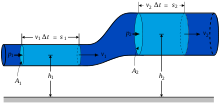- Newtonian fluid
-
Continuum mechanics  LawsScientists
LawsScientistsA Newtonian fluid (named after Isaac Newton) is a fluid whose stress versus strain rate curve is linear and passes through the origin.[1] [2][3] The constant of proportionality is known as the viscosity.
Definition
A simple equation to describe Newtonian fluid behaviour is
where
- τ is the shear stress exerted by the fluid ("drag") [Pa]
- μ is the fluid viscosity - a constant of proportionality [Pa·s]
 is the velocity gradient perpendicular to the direction of shear, or equivalently the strain rate [s−1]
is the velocity gradient perpendicular to the direction of shear, or equivalently the strain rate [s−1]
In common terms, this means the fluid continues to flow, regardless of the forces acting on it. For example, water is Newtonian, because it continues to exemplify fluid properties no matter how fast it is stirred or mixed. Other examples may be aqueous solutions, emulsions. Contrast this with a non-Newtonian fluid, in which stirring can either leave a "hole" behind (that gradually fills up over time - this behavior is seen in materials such as pudding and oobleck, or, to a less rigorous extent, sand), or climb the stirring rod (the Weissenberg effect) because of shear thinning, the drop in viscosity causing it to flow more (this is seen in non-drip paints, which brush on easily but become more viscous when on walls).
For a Newtonian fluid, the viscosity, by definition, depends only on temperature and pressure (and also the chemical composition of the fluid if the fluid is not a pure substance), not on the forces acting upon it.
If the fluid is incompressible and viscosity is constant across the fluid, the equation governing the shear stress, in the Cartesian coordinate system, is the tensor
A second tensor,
 (also written as
(also written as  ), representing the total stress, can be written by combining the shear stress with conventional (thermodynamic) pressure:
), representing the total stress, can be written by combining the shear stress with conventional (thermodynamic) pressure:where, by the convention of tensor notation,
- τij is the shear stress on the ith face of a fluid element in the jth direction
- p is thermodynamical pressure
- ui is the velocity in the ith direction
- xj is the jth direction coordinate
If a fluid does not obey this relation, it is termed a non-Newtonian fluid, of which there are several types, including polymer solutions, molten polymers, many solid suspensions and most highly viscous fluids.
See also
References
- ^ Batchelor, G. (2000). Introduction to Fluid Mechanics.
- ^ Kundu P and Cohen I. Fluid Mechanics.
- ^ Kirby, B.J. (2010). Micro- and Nanoscale Fluid Mechanics: Transport in Microfluidic Devices.. Cambridge University Press. ISBN 978-0521119030. http://www.kirbyresearch.com/textbook.
Categories:
Wikimedia Foundation. 2010.



